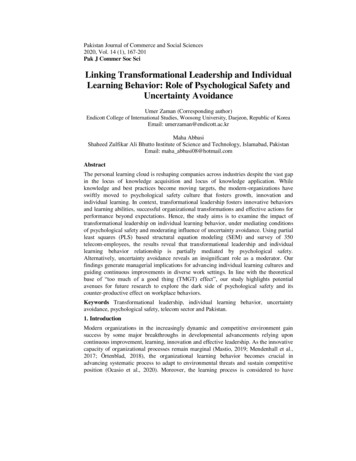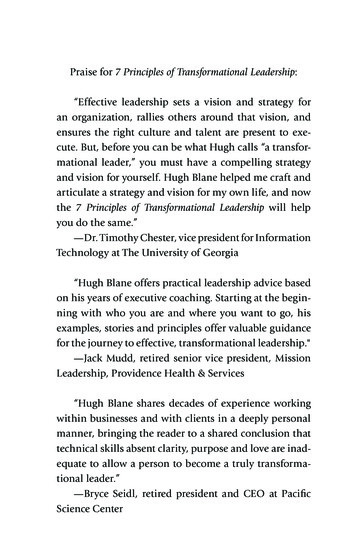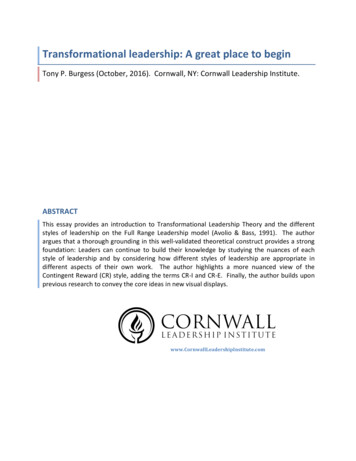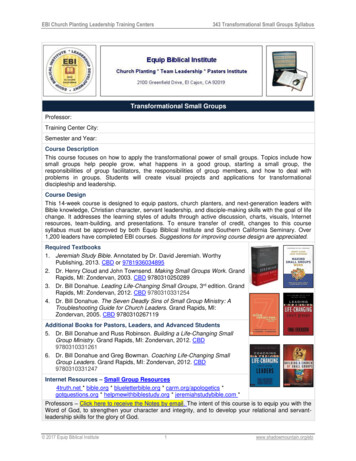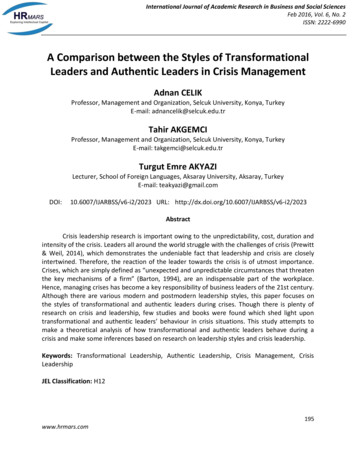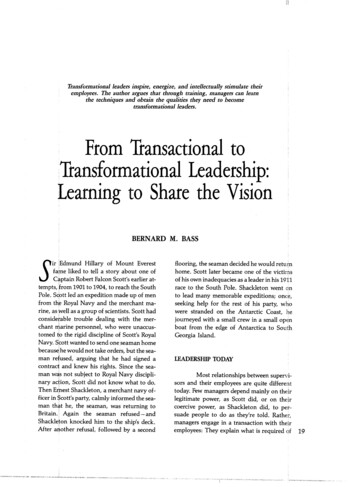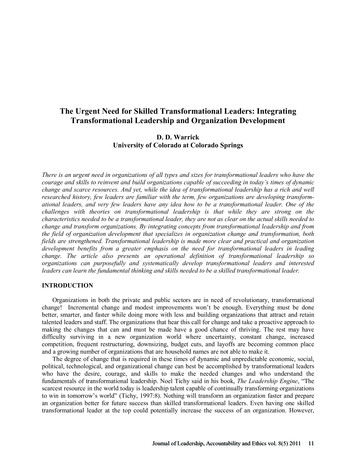
Transcription
The Urgent Need for Skilled Transformational Leaders: IntegratingTransformational Leadership and Organization DevelopmentD. D. WarrickUniversity of Colorado at Colorado SpringsThere is an urgent need in organizations of all types and sizes for transformational leaders who have thecourage and skills to reinvent and build organizations capable of succeeding in today’s times of dynamicchange and scarce resources. And yet, while the idea of transformational leadership has a rich and wellresearched history, few leaders are familiar with the term, few organizations are developing transformational leaders, and very few leaders have any idea how to be a transformational leader. One of thechallenges with theories on transformational leadership is that while they are strong on thecharacteristics needed to be a transformational leader, they are not as clear on the actual skills needed tochange and transform organizations. By integrating concepts from transformational leadership and fromthe field of organization development that specializes in organization change and transformation, bothfields are strengthened. Transformational leadership is made more clear and practical and organizationdevelopment benefits from a greater emphasis on the need for transformational leaders in leadingchange. The article also presents an operational definition of transformational leadership soorganizations can purposefully and systematically develop transformational leaders and interestedleaders can learn the fundamental thinking and skills needed to be a skilled transformational leader.INTRODUCTIONOrganizations in both the private and public sectors are in need of revolutionary, transformationalchange! Incremental change and modest improvements won’t be enough. Everything must be donebetter, smarter, and faster while doing more with less and building organizations that attract and retaintalented leaders and staff. The organizations that hear this call for change and take a proactive approach tomaking the changes that can and must be made have a good chance of thriving. The rest may havedifficulty surviving in a new organization world where uncertainty, constant change, increasedcompetition, frequent restructuring, downsizing, budget cuts, and layoffs are becoming common placeand a growing number of organizations that are household names are not able to make it.The degree of change that is required in these times of dynamic and unpredictable economic, social,political, technological, and organizational change can best be accomplished by transformational leaderswho have the desire, courage, and skills to make the needed changes and who understand thefundamentals of transformational leadership. Noel Tichy said in his book, The Leadership Engine, “Thescarcest resource in the world today is leadership talent capable of continually transforming organizationsto win in tomorrow’s world” (Tichy, 1997:8). Nothing will transform an organization faster and preparean organization better for future success than skilled transformational leaders. Even having one skilledtransformational leader at the top could potentially increase the success of an organization. However,Journal of Leadership, Accountability and Ethics vol. 8(5) 201111
what is most needed is transformational leaders throughout an organization. Is your organization staffedby transformational leaders? Are you developing transformational leaders? Your future may depend onit.UNDERSTANDING TRANSFORMATIONAL LEADERSHIPThe term transformational leader was originally developed by James MacGregor Burns (Burns,1978). Burns made a distinction between transactional leaders and transformational leaders.Transactional leadership describes the transaction that occurs between leaders and followers in gettingthe job done and achieving goals. In many ways it is another term for management. The leader makesclear what needs to be done and offers rewards in exchange for individual and group effort directedtowards goal attainment. Transformational leadership describes a process by which leaders bring aboutsignificant positive changes in individuals, groups, teams, and organizations (Avolia, Waldman, &Yammarino, 1991) by using inspiration, vision, and the ability to motivate followers to transcend theirself-interests for a collective purpose. Transformational leadership focuses more on leadership skills andtakes leadership to a new level of transforming organizations and setting them on a new course of action.Both transactional and transformational leadership are important. Organizations need to be well managedbut you can’t manage an organization to greatness. Greatness comes from leadership.Bernard Bass was also a pioneer in developing and researching the concept of transformationalleadership (Bass, 1985). He described specific behaviors that characterized transformational leaders suchas being a model of integrity and fairness, setting clear goals, having high expectations, encouragingpeople and providing support and recognition, stirring the emotions and passions of people, and gettingpeople to look beyond their own self-interests and reach for higher goals. Bass also identified severaldimensions of transformational leadership including (Bass, 1985, 1987, 1999, 2001, Bass & Avolio,1991, 1992):1. Idealized Influence (Bass originally called this charisma but later renamed it idealized influenceto describe providing a clear vision and mission, instilling pride in what needs to beaccomplished, and gaining respect and trust from leading with high moral and ethical standards)2. Inspiration (communicating high expectations, adding meaning to goals and undertakings, usingsymbols to focus efforts, expressing important purposes in simple ways, doing things to keeppeople motivated)3. Intellectual Stimulation (encouraging new and better ways of doing things, fostering creativity,re-examining assumptions, promoting intelligence, rationality, and problem solving)4. Individual Consideration (showing a personal interest in employees and their development)In addition, Bass played a major role in researching the impact of transformational leadership. Manyempirical studies have shown that transformational leadership is positively associated with improvementsin job satisfaction, job performance, and employee commitment and trust (Bass & Avolio, 1990; Bass,1999).Another key player in the development of the concept of transformational leadership was Noel Tichywho co-authored a book with Mary Anne Devanna titled The Transformational Leader (Tichy &Devanna, 1986). Tichy and Devanna point out that the old-style manager who managed what he or shefound and left things the same will no longer work and that companies need leaders who are willing tomake revolutionary changes that will enable them to stay competitive in an increasingly internationalbusiness environment. They outline a three step process for transforming organizations:1. Revitalization (recognizing the need for change)2. Creating a new vision3. Institutionalizing changeTheir view of a transformational leader is of a visionary leader with new ways of thinking aboutstrategy, structure, and people as well as about change, innovation, and having an entrepreneurial12Journal of Leadership, Accountability and Ethics vol. 8(5) 2011
perspective. They also believe that transformational leadership is a systematic process that can be learnedand managed.There have been many other contributors to the thinking and research on transformational leadership.Figure 1 summarizes some of the major characteristics of transformational leaders. These ideas should bevery instructive to leaders who aspire to being transformational leaders and to organizations committed todeveloping transformational leaders.POTENTIAL PAYOFFS OF TRANSFORMATIONAL LEADERSHIPIt is surprising that there isn’t a stronger interest in transformational leadership considering its manydocumented payoffs. The extensive research on transformational leadership indicates that it can create ashared vision and commitment to higher level goals and builds respect and trust between leaders andfollowers. It can also improve the performance of individuals, groups, teams, and organizations andincrease innovation, creativity, and the involvement and engagement of employees in makingimprovements. It is effective at empowering employees, improving employee motivation and satisfaction,and reducing employee stress and burnout. Figure 2 summarizes some of the research on the manypotential payoffs of transformational leadership.INTEGRATING TRANSFORMATIONAL LEADERSHIP AND ORGANIZATIONDEVELOPMENTThe field of organization development (OD) had its early roots in the 1940s through the work of KurtLewin and the Research Center for Group Dynamics that he founded at the Massachusetts Institute ofTechnology in 1945 (Brown, 2011, p 8). Through the inspiration of Lewin, Kenneth Benne, LelandBradford, and Ronald Lippitt pursued further studies of groups and later whole organizations byestablishing the National Training Laboratory (NTL) in Bethel Maine in 1946 (Anderson, 2010, p 16).However, it was the late 1950s and early 1960s when the term organization development started beingused and books on the subject appeared. It isn’t clear whether the term was created by Richard Beckard,Robert Blake and Jane Mouton, or Herbert Shepherd, but all were involved in the early stages of OD as afield. Richard Beckard’s early definition of OD is still among the most popular:“OD is an effort (1) planned, (2) organization-wide, and (3) managed from the top, to (4)increase organizational effectiveness and health through (5) planned interventions in theorganization’s processes using behavioral science knowledge” (Beckhard, 1969).After studying definitions of OD and soliciting new definitions from leaders in the field of OD,Warrick (2005, p 172) concluded that:“OD is a planned and collaborative process for understanding, developing, and changingorganizations to improve their health, effectiveness, and self-renewing capabilities.”In reviewing the fields of transformational leadership and organization development, it seems obviousthat the two fields are interrelated and that adding an OD perspective to transformational leadership and atransformational leadership perspective to OD strengthens both concepts. However, organizationdevelopment concepts are rarely mentioned in the transformational leader literature and transformationalleader concepts are seldom mentioned in the OD literature. The books and articles on transformationalleadership do an excellent job of describing what transformational leaders do and virtues and payoffs.However, little is said about the skills actually required to change and transform whole organizations,departments, and teams. Thus, a transformational leader may be skilled at being a visionary leader whocan motivate and inspire people but may at times fail to achieve the desired results for a lack ofunderstanding of what is involved in organization change and transformation. Tichy and Devanna in theirJournal of Leadership, Accountability and Ethics vol. 8(5) 201113
1986 book titled The Transformational Leader probably comes the closest of the transformationalleadership authors to addressing organization development concepts such as managing change althoughthe term organization development is never mentioned in their book.Interestingly, the multitude of books and articles on organization development provide valuableinformation on how to develop, change, and transform organizations but draw little from the wealth ofresearch on transformational leaders and the critical role they play in building healthy, high performanceorganizations and managing change and transforming organizations. From what is known abouttransformational leaders, it would make sense that when transformational leaders are involved in ODefforts, the odds of success and of accelerating the change process could be significantly increased. Infact, a strong case could be made that developing transformational leaders should be one of the early stepsin the OD process.AN OPERATIONAL DEFINITION OF TRANSFORMATIONAL LEADERSHIP THATINTEGRATES TRANSFORMATIONAL LEADERSHIP AND OD CONCEPTSBy creating an operational definition of transformational leadership that integrates transformationalleadership and organization development concepts, it is possible to identify and define the skills needed tobe an effective transformational leader and to train leaders on the skills. The definition of transformationalleadership used in the model shown in Figure 3 is that transformational leaders are leaders who are skilledat leading, championing change, and transforming organizations. The first skill, leading, relies primarilyon the transformational leadership literature while the next two skills, championing change andtransforming organizations rely primarily on the organization development literature. Figure 4 providesan opportunity for leaders to evaluate their transformational leadership skills based on the modelpresented in Figure 3. The discussion that follows will focus on the model presented in this article.However, the greater goal is to encourage others to develop understandable and useable transform-ationalleadership models that integrate the best of transformational leadership and OD concepts and can be usedto train transformational leaders. A description of the three skills follows.LEADINGTransformational leaders first have to be skilled leaders. Few topics have received so much attention.And yet, with so much written about leadership and so much leadership education and coaching available,there seems to be a scarcity of good leaders and a lack of understanding of the fundamentals of leadershipin both the private and public sectors.It is not the purpose of this article to discuss the extensive literature on leadership but rather to createan operational definition that incorporates transformational leadership concepts that can be used intraining leaders. Leading in the model presented is defined as the process of providing vision, direction,and inspiration (Warrick, 1995). These are skills that can be learned. When leaders lead they raiseaspirations, unite people around common goals, and inspire people to excel. However, when leaders don’tlead, the result is a lack of focus, direction, and unity, inefficiency, underutilization of potential, politicalmaneuvering, a lack of confidence in leaders, and an inability to change and transform organizations.Providing vision means giving people a clear picture of where the organization needs to go or of whatneeds to be done and why. Visionary leaders are most effective when they have a passion for what can beaccomplished and are committed to elevating the performance and standards of people, groups, andorganizations. An actual vision can be shaped by the leader or by involving others and can include longterm aspirations, an important goal, or short term tasks. It can be used in vision statements or simply indescribing something that needs to be accomplished. When people understand what needs to be done andwhy, they are likely to be more committed, focused, and united. If it is used as a statement such as for thelong term vision of an organization, it should be short and memorable and change the way people thinkand act. Otherwise it will have little impact. Being a visionary leader may be a gift that some leadershave. However, more often than not it comes from studying situations, being well informed enough to14Journal of Leadership, Accountability and Ethics vol. 8(5) 2011
know what is possible, having a passion for excellence and accomplishing something special, and havingthe discipline to work at communicating ideas in a simple and understandable way.Skilled leaders also provide direction on what it will take to get things done. Vision defines the targetand direction clarifies what it will take to get there. Direction typically is communicated in terms of goals(what needs to be done), values (how things should be done), and priorities (what is most important). Itcan be done formally or informally and by the leader or others empowered or designated by the leader.The leader’s role is to make sure that the direction is as clear as possible, that there is commitment to thedirection, and that employees are empowered to accomplish what needs to be done and held accountable.Some leaders are skilled visionary leaders but do not provide the direction needed to accomplish thevision. Getting people invested in a worthy goal or task without providing direction on what it will take toget there will eventually result in frustration or apathy.The key to bringing life to vision and direction is inspiring people to excel and to persevere. Bassoriginally called this charisma but later changed the term to inspiration. While being charismatic caninspire people it is also difficult to maintain. Inspiration is not dependent on charisma. It comes frombeing passionate and enthusiastic about what you are doing and trying to accomplish and from walkingthe talk, being a person of integrity and honesty, being a consistent example worthy of following, andtaking a genuine interest in people and their success and development. Inspirational leaders are upliftingto be around. They engage and involve people, listen to their ideas, and motivate and empower them tosucceed.It is important to add to this discussion on developing skills in leading the findings of Jim Collins inhis best-selling book Good to Great (Collins, 2001). Collins and his research team studied 1135organizations and found only 11 that met their stringent criteria for going from good to great. The elevenleaders of these organizations all had two characteristics in common. They had a strong professional will(commitment to excellence) that was contagious and they were all known as humble leaders (modest,open, approachable, and others oriented rather than self oriented, pompous, arrogant, and over-confident).Professional will inspires excellence and humility creates a climate of openness that is essential toknowing what is going on and having accurate information to base leadership decisions on.CHAMPIONING CHANGENext to skills in leadership, skills in championing change may be the most important skills leadersneed to develop in these times of dynamic change. Unfortunately, few leaders have been trained how tochampion change. Consequently, organizational changes experience a 70% or more failure rate (Burke,2008, Doyle, 1992, Miller, 2002, Senge, 1999). Even the right changes implemented the wrong way arelikely to fail and frequent failures at implementing change undermine confidence in leaders and the desireto support changes.In this article championing change will be described as skills in initiating, facilitating, andimplementing change (Warrick, 2009). Initiators of change lead and sponsor needed changes. They arewell-informed about issues, opportunities, and how to get things done. They have a change mindset,always looking for new and better ways to do things. They are also skilled at facilitating change bygetting the right people together to explore ideas and plan changes and by guiding change relatedmeetings and paving the way to accomplish needed changes.The third skill in championing change is perhaps the most important of the three skills. Implementingchange requires skills in using a sound change process to successfully design, manage, and sustain thedesired change. This is a critical skill for transformational leaders and a skill that can be learned bytraining leaders to use a change model (see for example Lewin, 1951, Beckhard and Harris, 1977, Nadlerand Tushman, 1989, Warrick, 1995), a change checklist to guide leaders through the change model, and aform for designing changes (see Warrick, 2005). Leaders may lead the implementation of change or makesure that a person skilled in implementing change is leading the change process.Journal of Leadership, Accountability and Ethics vol. 8(5) 201115
TRANSFORMING ORGANIZATIONSHow many leaders do you know who have been trained how to transform organizations or whonaturally possess these skills? Even though the need to transform organizations and prepare them tosucceed in today’s times is great, this critical skill is typically overlooked in training leaders. It isinteresting to consider that although the term “transformational” defines a transformational leader, there islittle guidance offered in the literature about how to actually go about transforming an organization.The term transform means to fundamentally change something or someone from one state to another.From an organizational perspective it means that everything, except perhaps the core values of anorganization, assuming they are known and used, is up for consideration in making the organizationstronger and better. While OD has focused from the beginning on developing healthy, high performanceorganizations and successfully managing change, the emphasis on transforming organizations is a morerecent development. Interestingly, in 1994 the most popular OD readings book changed the title toinclude a threefold emphasis when the title of the new edition became Organization Development andTransformation: Managing Effective Change (French, Bell, and Zawacki, 1994). The addition oforganization transformation (OT) to the title reflects the emphasis now being placed on transformingorganizations. In the introduction to their book, French, Bell, and Zawacki said:“Organization transformation (OT) is a recent extension of organization developmentthat seeks to create massive changes in an organization’s structures, processes, culture,and orientation to its environment. Organization transformation is the application ofbehavioral science theory and practice to effect large-scale, paradigm-shiftingorganizational change.”For purposes of this article, transforming organizations is described as an on-going process ofknowing present realities, identifying future ideals, and developing and implementing a process fortransforming organizations. The term organizations is intended to include whole organizations,departments, teams, and other forms of organizations.It makes sense that before transforming an organization it would be important for leaders to be wellinformed about present realities and be clear on the future ideals they are trying to move organizationstowards. Leaders are often out of touch with the realities of the organizations they lead, change, andtransform. This can create an illusion of doing well while the organization is regressing that results inflawed plans that treat symptoms rather than the real issues (Warrick, 2002). Therefore, it is essential thatleaders have a keen awareness of present internal and external realities of the organizations they leadbefore trying to transform them.They also need to define and articulate future ideals that describe what the organization ideallyaspires to. To do this leaders along with others need to study future industry trends and best practices andstate-of-the-art thinking about best run organizations and what it takes to build a healthy (excellent andmotivating culture and place to work), high performance (identifiable results that exceed the norm), selfrenewing (quick to adapt to change and offers opportunities at all levels to learn grow, stay up-to-date,and contribute) organization. If they can define and clearly communicate the ideals in simple, compellingways, they have a high probability of rallying people to help them accomplish the ideals.The third skill in transforming organizations is to develop and implement a process for transformingorganizations. There are few models available on how to transform organizations. Perhaps the best andmost popular is John Kotter’s model presented in his classic book titled Leading Change (Kotter, 1996).His model includes eight steps: (1) establishing a sense of urgency; (2) creating the guiding coalition; (3)developing a vision and strategy; (4) communicating the change vision; (5) empowering employees forbroad based-action; (6) generating short-term wins; (7) consolidating gains and producing more change;and (8) anchoring new approaches in the culture. He expanded on this model in a later book co-authoredwith Dan Cohen titled The Heart of Change (Kotter and Cohen, 2002). In this book the authors emphasizethe importance of engaging hearts (feeling, emotions) and not just minds in committing to change. While16Journal of Leadership, Accountability and Ethics vol. 8(5) 2011
the eight step model is excellent for transforming organizations, it does not mention transformationalleadership or OD concepts.In accomplishing transformational change in organizations, it is important to develop a soundtransformation process, train leaders on the process, appoint a transformation team to help guide theprocess, and seek internal or external professional guidance in developing, executing, evaluating, andimproving the process. An example of a transformation process is shown in Figure 5.GUIDELINES FOR DEVELOPING SKILLED TRANSFORMATIONAL LEADERSOrganizations that recognize the considerable potential payoffs of having transformational leaders atthe top and hopefully throughout the organization need to have a plan for developing transformationalleaders. Even the best of leaders, with rare exception, are not likely to be skilled at transformationalleadership as this important type of leadership requires critical skills in leading, championing change, andtransforming organizations that leaders may not be aware of or possess.Traditional training methods that provide knowledge and hope that the knowledge will be applied arenot likely to be adequate for developing transformational leaders. In designing programs for developingtransformational leaders and realizing the potential benefits the following guidelines are recommended:1. Assure top level support and involvement: Build top level commitment to the program andassure that top level leaders participate in the training. They can be the first to be trained or betterstill join with other levels of leaders in the training.2. Appoint a design team to plan the training and develop a transformational leadershipmodel to be used in the training: A design team made up of at least one top level leader andrespected leaders from different levels of the organization should be organized to work withinternal or external professionals to help design the program, develop a transformationalleadership model to be used in the training, and build commitment to the program.3. View the program design as an intervention and not an event: Transformational leadershiptraining should be used as an opportunity to impact people, teams, and the organization and topossibly transform the organization. The top level leaders and design team should explore how todesign the program for impact both during the program and following the program.4. Make sure the program is designed to change the way people think and provideopportunities to practice new behaviors and develop new habits: To actually change thebehavior of the participants programs need to be designed to change the way people think(training that provides compelling and applicable knowledge and learning experiences), createopportunities to practice skills both in the training and outside the training, and allow enough timefor the practice to become habits (new ways of behaving).5. Plan follow-up actions to apply what has been learned: Participants should be givenassignments to apply what they are learning. It is important to keep the assignments useful anddoable so they don’t overload the participants. For example, it may be helpful to have eachparticipant commit to one significant personal change, one change that will improve or transformthe group they lead, and one change personally or in a group that would improve or helptransform the organization.6. Provide coaching and help in applying the course: The probability of applying what is beinglearned will increase significantly if participants have coaching or help available.7. Evaluate and improve the process and plan future actions: It is important for the design teamto evaluate and improve the process and to plan ways to sustain the change and momentum thathas been gained, to continue the emphasis on transformational leadership, and possibly to workwith the leaders in developing a plan to transform the organization.A well designed transformational leadership program has considerable potential to develop skilledtransformational leaders and to have a significant impact on the performance of people, teams, andJournal of Leadership, Accountability and Ethics vol. 8(5) 201117
organizations and the culture of an organization. One can well imagine the ripple effect of having each ofthe participants involved in making personal changes and improving or transforming the groups they leadand contributing to the improvement or transformation of the organization.CONCLUSION AND CHALLENGEIn today’s times of fierce competition and dynamic, non-stop change, there is a need fortransformational leaders and for organizations to have a sense of urgency in developing transformationalleaders. The payoffs can be substantial! There is also a need to integrate transformational leadership andorganization development concepts and when this is the case both concepts are strengthened. Finally,there is a need to develop operational definitions of transformational leadership that can be used to trainskilled transformational leaders. It is the purpose of this article to make addressing these needs a highpriority for organizations and to help them recognize the payoffs of doing so.REFERENCESAnderson, Donald L. (2010). Organization Development: The Process of Leading OrganizationalChange. Thousand Oaks CA: Sage Publications.Arzu, Ilsev & Lale, Gumusluoglu (2009).
Transformational leadership is made more clear and practical and organization . The books and articles on transformational leadership do an excellent job of describing what transformational leaders do and virtues and payoffs. However, little is said about the skills actually
